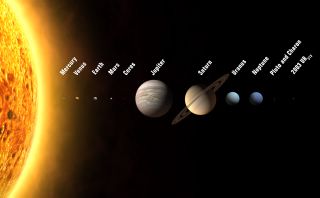
Our solar system - big, isn't it?
The IAU has proposed new nomenclature for naming objects that orbit suns.
Their proposal will be voted on, in
Here are his suggested terms and definitions:
FUSOR - an object that achieves core fusion during its lifetime.
PLANEMO - a round non-fusor.
PLANET - a planemo orbiting a fusor.
To wit: “A planet is a planemo orbiting a fusor.”Short, sweet, succinct, and observationally scientific. Empirical.
Contrast the above with the IAU’s proposal:
"A planet is a celestial body that (a) has sufficient mass for its self-gravity to overcome rigid body forces so that it assumes a hydrostatic equilibrium (nearly round) shape1, and (b) is in orbit around a star, and is neither a star nor a satellite of a planet."
Both definitions concur on what is a planet. However they differ in how they define what isn't one. More specifically, Basri makes planets a sub-set of a broader group of objects - planemos. The IAU decided to introduce a new set, one distinct from planets, but which shares some similar attributes. Introducing, the pluton:
A "pluton" is an object satisfying the technical (hydrostatic equilibrium shape in the presence of self-gravity) definition of "planet." Plutons are distinguished from classical planets in that they reside in orbits around the Sun that take longer than 200 years to complete (i.e. they orbit beyond
This pluton business bugs me. That last line is especially bothersome:
“All of these distinguishing characteristics for plutons…suggest a different origin from the classical planet.”
Perhaps I missed the lecture on The Definitive Theory on the Origin of Classical Planets. Aren’t there only hypotheses for how *any* celestial object forms? If so, isn’t it illogical to define plutons as apparently unique objects, when you can’t empirically show they have a different origin from classical planets? If you don’t know how classical planets formed, how can you suggest plutons formed differently and are therefore intrinsically unique?
Basri didn’t see a need for this new pluton. He was happy to let adjectives clarify the (arguably) less significant observational distinctions. For example, Ceres & Pluto would simply be called minor planets. There would be 8 major planets. If you wanted to, you could still, quite logically, refer to 9 historical planets. Further, he had no fundamental problem with calling Pluto both a planet (a minor one) and a Kuiper Belt Object (KBO).
For him, it all boils down to what aspect of the object you're concerned with. When you call Pluto a planet, you’re describing a characteristic. Saying it’s a KBO refers to its circumstance. The cosmogony of objects (their formation mechanisms & histories) is less understood and far less observable than their characteristics and circumstances, and the ISU seems to me to be bringing in some cosmological assumptions where they ought not belong.
Basri's 2003 article makes the case clearly and, to me, convincingly.
Here is the IAU Q&A page, for further 'clarification.'
Coming to you, from the third stone from the sun.





1 Comments:
Planet Mass
Post a Comment
<< Home